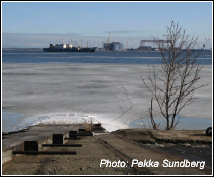 |
|
Nitrogen Emissions Higher than Expected
|
By Minna Alhosalo and Juha Kalli
The Baltic Sea is one of the most polluted seas in the world. The most severe environmental problem is the eutrophication caused by nitrogen and phosphorous. Every summer, the massive algae blooms become problematic for people living around the Baltic Sea. The state of the sea has been studied intensively to allocate the protection activities properly.
 In the end of 2007 the HELCOM Baltic Sea Action Plan was accepted. It includes four sections; eutrophication, hazardous substances, biodiversity and nature conservation and maritime activities. The objective is to reach a good environmental status of the Baltic Sea by 2021. A remarkable growth of the sea traffic increases also the environmental impact on the sea transport. Recently the public attention has been especially concentrated on the eutrophication caused by the nitrogen emissions from shipping. The University of Turku Centre for Maritime Studies has participated in a project which objective was to demonstrate the environmental impact of the ship originated nitrogen oxides. Furthermore, several types of scenarios of the emissions have been executed. The project was realized in collaboration with Finnish and Estonian stakeholders. In the end of 2007 the HELCOM Baltic Sea Action Plan was accepted. It includes four sections; eutrophication, hazardous substances, biodiversity and nature conservation and maritime activities. The objective is to reach a good environmental status of the Baltic Sea by 2021. A remarkable growth of the sea traffic increases also the environmental impact on the sea transport. Recently the public attention has been especially concentrated on the eutrophication caused by the nitrogen emissions from shipping. The University of Turku Centre for Maritime Studies has participated in a project which objective was to demonstrate the environmental impact of the ship originated nitrogen oxides. Furthermore, several types of scenarios of the emissions have been executed. The project was realized in collaboration with Finnish and Estonian stakeholders.
The ShipNODep project is unique in a way that the calculations are based on the real on-line traffic data. The emission calculation algorithm uses the automatic identification system (AIS) data as an input information. Thus 3500 vessels and their movements can be observed. The produced emission data can be drawn on a map to model the deposition of nitrogen oxides to the sea in a function of time. As a result, the nitrogen oxide emissions from shipping were calculated to 370 000 tons per year. The result is probably underestimated but nonetheless higher than earlier estimations.
According to the ShipNODep study, the share of the ship originated nitrogen emissions is higher in northern parts of the Baltic Sea. In the southernmost area, "the background concentrations" of the emissions are on a such high level that the emissions from shipping are challenging to distinguish. This phenomenon occurs as a consequence of the emissions drifted from the Central European industry and traffic. The potential legislation to restrict the emissions from shipping would thus benefit most the northern parts of sea.
|
Further information:
Ms Minna Alhosalo
Researcher, University of Turku
Centre for Maritime Studies
Phone: +358 23338102
http://mkk.utu.fi/en
|
|
|